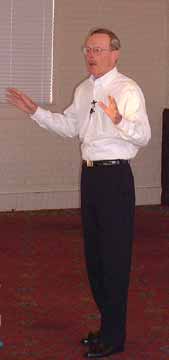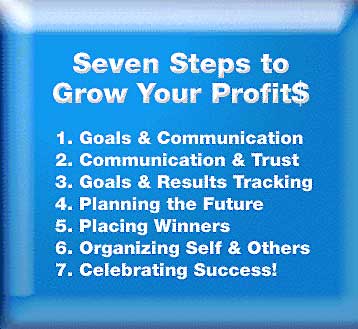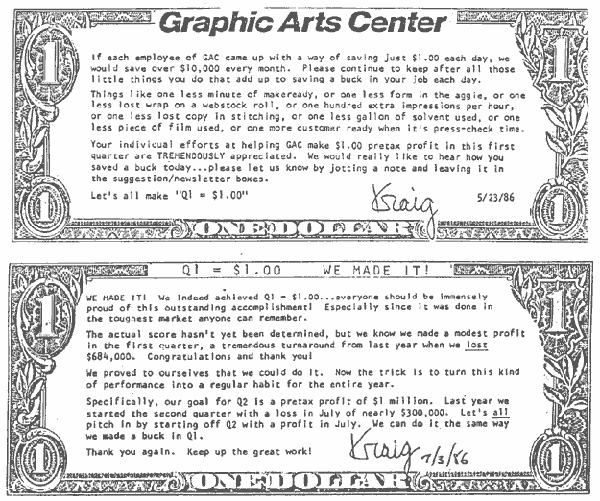Management Tools for Parking Area Sweeping |
 |
 Kraig Kramers hit a home run with the room full of attendees at the 2002 APWA conference.
Kraig Kramers hit a home run with the room full of attendees at the 2002 APWA conference.Kramers, who has been the CEO of 8 different companies, possesses a wealth of information applicable to anyone who runs a business. During his 4-hour presentation, the dynamic Kramers -- who seemingly miscasts himself as an "introvert" -- described many proven techniques for improving business operations, sales and planning. Additionally, he provided all attendees with a thick stack of handouts for future reference. Nearly everyone I spoke with after Kramers' presentation thought the information they received from the talk more than covered their APWA trip investment. For those who missed it, here are some of Kramers' ideas from what he calls a "CEO's Toolkit." By Ranger Kidwell-Ross, editor of World Sweeper magazine. 
Something most every company owner can relate to is Kramers' emphasis on the importance of operating a business under a continuous process of renewal. This isn't too surprising, given that a number of his own stints as CEO were as a 'hired gun turnaround specialist.' One of his central concepts is to invest 20 minutes every day in "walking the 4 corners of your enterprise, asking questions of your employees and paying close attention to their answers. " Kramers also advises that it is much easier to build relationships with your direct report personnel by encouraging conversations about their personal lives. "If you relate to people strictly on a business level, you won't be able to build the same quality of relationship as when you're in touch with their personal lives as well," he told us. 
As proof that these concepts work, he cited the impressive results during his stint as CEO of the well-known mower manufacturer, Snapper. When he took over, Kramers said, the company had been losing money for the previous 18 months. By setting his goals high and listening to the employees' ideas about how to become profitable, the company began making money 45 days later. Have your employees set their own goals, advises Kramers, and they'll set them higher than if you're the one setting them. They'll also be more likely to reach the goals they're involved in setting. The importance of getting 'buy-in' by employees is a topic Kramer gave examples of again and again, in all areas of business. Your goals for growth and profitability should be "reaching but reasonable" he said. To get the buy-in you want from your employees, be sure to establish financial levels for them that provide a dollar amount they are excited about receiving if they meet their goal. Once your budget is in place, he advises setting an even higher goal structure that, although it appears unattainable, provides an even higher goal to reach for and an even higher compensation increase rate for "the money we wouldn't have otherwise made." He gave us an example from one of his companies where a sales manager made a seemingly impossible increase in sales volume when a $30+ thousand grand piano was dangled at the end of his and his wife's rainbow. Throughout this process, don't let your employees wonder about how the company and its goals are doing. If you do, Kramers warns, they'll be worrying instead of working. He suggests sending a 1-page letter to all your employees to outline your goals and how each employee fits into it. Then, keep communicating the company's goals throughout the year, so your employees have a clear understanding of the overall direction of the firm, in both the short- and long-term. Kramers cited a number of actual techniques he uses for communication. One was a monthly listing of the top salespeople in the company that was distributed throughout the enterprise. "I never make any mention of the people who aren't hitting their targets," he said. "Their omission, alone, provides encouragement for them to increase their level of effort. "Always pit your salespeople against what they, themselves, did in the same month last year, rather than against each other. You don't want to create a 'winners and losers mentality' in your company, because then you have to deal with the losers. If everyone keeps doing better than they did in the same month the previous year, you'll all keep growing." Refreshingly, Kramer provided equal emphasis on another way to improve the bottom line -- cutting costs. "By walking the 4 corners every day and communicating/listening to what's going on in your company, you will build relationships and trust with your employees," he advised. "They will then become willing participants in working to achieve the company's goals." His seminar handouts included copies of memos to his workforce asking for their help in reducing waste, being more productive, and doing the job right the first time. These included specific examples as ideas. For a sweeping contractor, these might include suggestions such as keeping equipment cleaner so it lasts longer, making 'just stopping by' sales calls at the location next to where you're working, or finding ways to reduce shop waste. Keep track of where you're trying to go and how you're doing in the process of getting there. "What gets measured gets done," he said. "Then, whenever goals are met, take a moment to celebrate the achievement. This is the only way for employees to release the old goals and move on to the new ones." Besides, Kramers advises, it's also important to make the workplace enjoyable, if not downright fun. He reminded us that every individual needs recognition, personal growth, challenge, communication, convenience, compensation, fun and security. In his opinion, recognition pays off a thousand to one over compensation. When employees are surveyed about what they're not getting at their company, the top two are typically communication and recognition. Usually compensation is about #8 on the list. "If you give someone an extra dollar for doing a good job, the next time they do a good job, they'll want two dollars. If you reward them with recognition, they'll want to do a good job the next time so they can achieve more recognition." Kramers recommends a book by Bob Nelson, 1001 Ways to Reward Employees, as a tool for adding fun to your company. His advice was to "Appoint a company CFO: a Chief Fun Officer." 'Big Audacious Goals' are a concept Kramers recommends for keeping your company atmosphere from becoming stale. If you don't, you lose your best people. You'll never know what goals you can reach if you don't risk failing by going for the big ones. The seemingly impossible can be attained, he assured us (and then backed it up with numerous examples from his own illustrious career), if you get commitment from your employees as far as what they think they can achieve, and make the process FUN. Then, celebrate the successes by giving them WIIFMs: What's In It For Me. Kramers believes that the weakest link in all companies is communication. In addition to what he learns, and the relationship level he is able to build in his daily 20-minute walk-around routine, he cites many examples of how to improve communications with employees at all levels of the large companies he worked with. Kramer emphasized the buy-in he was able to achieve -- from upper level managers to the bottom tier of employees -- through communicating the company's goals via memos, letters, signs, banners, etc. 
For example, one of his companies was leading fine color commercial printer in the U.S. Although overall profitable, Kramer told us, the company had lost money in the first quarter for 94 of its 95 years in business. The firm had lost $750,000 in the first quarter the previous year. Using a campaign, keynoted by signs that proclaimed 'Qtr 1=$1,' he embarked the company on a quest for making just one single dollar of profit in the upcoming first quarter.  They made a game out of finding some way to make that dollar's worth of profit. The methods they used included more aggressive pricing, pre-selling accounts for later work, encouraging cost-cutting and better productivity practices, and having strong rewards available for a positive result. The ultimate outcome was that they made over $200,000 for the quarter. It was an exciting, real-world example of what Big Audacious Goal-setting, combined with fun in the workplace, can achieve. We have two other examples of the $1 campaign handouts online. And now, here's Part Two. |
© 2006 - 2010
|
Parking Area Sweeping Contents
|